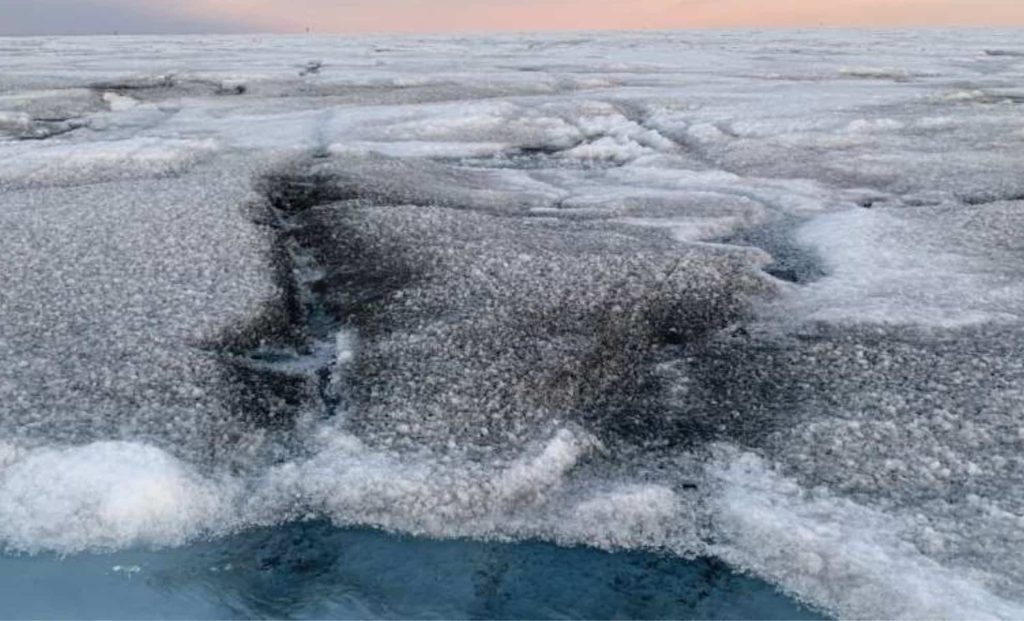Unexpected Growth on Greenland’s Ice Could Have Major Impacts on Melting Rates – Indian Defence Review

A recent discovery in Greenland reveals a surprising factor that could accelerate the melting of the Greenland Ice Sheet. Researchers have found that algae, thriving on exposed parts of the ice, could contribute to an increase in ice sheet melting. These algae, which have been present for years, are now spreading more rapidly, darkening the ice and making it absorb more heat from the sun. This process could contribute to faster sea level rise, a growing concern in light of climate change. Recent research has revealed a startling connection between algae and the accelerating melting of Greenland’s ice sheet. As global temperatures continue to rise, pigmented algae, particularly species such as Ancylonema, are thriving on the exposed surface of the ice. These algae are significantly contributing to the darkening of the ice, which in turn increases the absorption of heat and accelerates melting. This discovery not only raises concerns about the Greenland Ice Sheet’s stability but also how the algae’s spread could contribute to faster sea level rise.The impact of this algae bloom could be profound. These organisms, which have been observed for some time, could soon increase in number and spread across more of the ice sheet, potentially exacerbating the already accelerating ice loss. Scientists have long known that darker surfaces absorb more heat than lighter ones, and this could create a dangerous feedback loop, accelerating the melting process even more.Algae, which has always been present on the surface of ice sheets, is now blooming at an unprecedented rate. As global temperatures rise, the snowline in Greenland is shifting higher, exposing more of the ice to the elements. This has created the perfect conditions for algae growth, especially Ancylonema, a species of pigmented algae. These algae bloom in the ablation zones, where the ice sheet is exposed due to seasonal melting. The algae darken the surface of the ice, which increases its ability to absorb sunlight, further accelerating the melting process.James Bradley, a researcher at the Mediterranean Institute of Oceanography, explains that while algae have always been present on ice sheets, the intensity and spread of these blooms could have serious consequences for the future:“These algae are not a new phenomenon, but if they bloom more intensely, or the bloom is more widespread, then it would be an important thing to consider in future projections of sea level rise.”As the ice absorbs more sunlight, it melts faster, creating a feedback loop where the ice loss itself facilitates even more algae growth. This self-reinforcing cycle could make the Greenland Ice Sheet more vulnerable to accelerated melting, making it a critical factor in the global sea level rise equation. The implications of this process were highlighted in a study published in Nature Communications on February 19, 2025, revealing how biological factors like algae are playing a more significant role in Greenland’s ice dynamics and contributing to global sea level rise.In their study, Bradley and colleagues collected algae samples from the south-west tip of the Greenland Ice Sheet, where they used advanced imaging techniques to examine the algae in detail. Their findings suggest that the algae thrive in environments that contain very few nutrients, making their growth even more impressive. Despite the limited resources, the algae are able to flourish, likely aided by rising temperatures and melting ice.As global warming continues to impact the region, scientists are particularly concerned that these algae may spread further up the ice sheet as the snowline moves to higher altitudes. This could worsen the melting in previously untouched areas, leading to even faster ice loss. Christopher Williamson, a researcher at the University of Bristol, who was not involved in the study, commented on the breakthrough, focusing on how the algae thrive despite the challenging conditions:“One big part of understanding this puzzle is how much nutrient is needed by the glacier algal cells and whether they are able to efficiently take up and store the scarce nutrients available in the system. This study does a great job of demonstrating these things using cutting-edge methodologies.”This discovery highlights the complex interactions between climate change, biological factors, and ice sheet dynamics, which could significantly alter future climate projections. The accelerating impact of algae growth on the Greenland Ice Sheet could contribute to higher sea level rise estimates in the coming decades.The newly discovered impact of algae on the Greenland Ice Sheet could have profound implications for future sea level rise projections. As Alaskan glaciers and polar regions become increasingly vulnerable, this finding stresses the need for an updated understanding of how biological factors like algae play a role in melting. Greenland’s ice is one of the largest contributors to global sea levels, and as the ice sheet continues to melt, rising oceans could affect millions of people worldwide, especially those in coastal regions.This study provides a clearer picture of the accelerating forces that contribute to Greenland’s ice melt, revealing the importance of monitoring biological factors alongside traditional climate models. While many studies have focused on temperatures and ice sheet dynamics, this discovery calls attention to the biological contributors that could significantly alter future projections.By understanding how algae and other factors are influencing ice melt, scientists can develop more accurate models to predict sea level rise and plan for potential impacts. The feedback loop created by the algae’s role in melting ice is a reminder that climate systems are deeply interconnected, and even small biological changes can have massive, long-term effects on the planet’s climate and sea levels.Comment Save my name, email, and website in this browser for the next time I comment.
© 2024 | Indian Defence Review | All rights reserved
Source: https://indiandefencereview.com/growth-greenlands-ice-impacts-melting/





